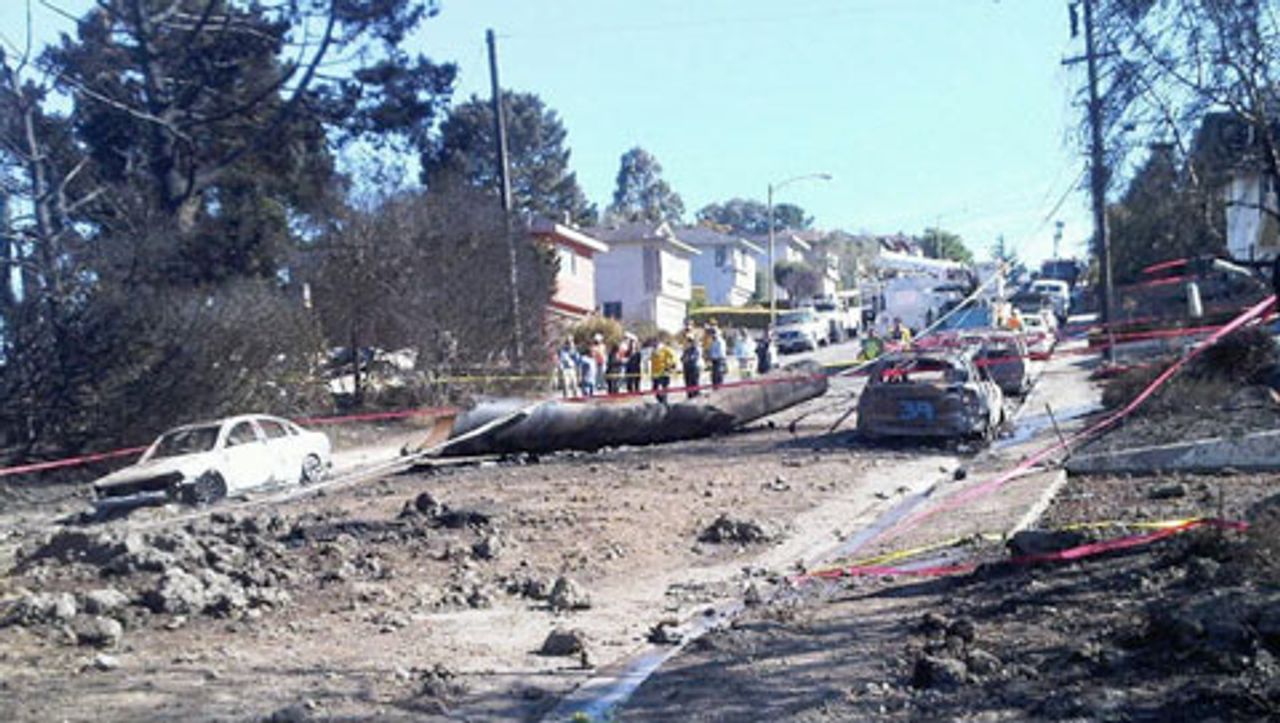 A scene of the devastation in the San Bruno neighborhood
A scene of the devastation in the San Bruno neighborhoodThe death toll from Thursday’s gas pipeline explosion in San Bruno, California has risen to seven, with six more still missing. At least sixty people have been injured, some critically.
As stunned residents begin to return home, information is emerging that points to infrastructure decay and neglect as elements in the tragedy. The pipeline near the explosion was categorized as “highest risk” because of its proximity to a highly populated area, but the more than 50-year-old pipeline was never replaced.
Three of the missing are members of the Bullis family—Greg Bullis, his teenage son William, and his elderly mother Lavonne. In a statement to Bay Area news outlet KGO, other members of the family expressed concern that local officials were deliberately covering up the number of dead and missing so as to diminish the impact of the disaster in the press. Trained dogs have located a total of nine cadavers, but officials have yet to confirm they are human remains.
The scale of the disaster is also coming into sharper relief. Media reports have begun to include before-and-after Google Earth photos showing the tree-lined neighborhood appearing as if a massive bomb hit it. The number of destroyed homes has been revised up to 40, while the number of severely damaged homes is in the hundreds.
The National Transportation Safety Board (NTSB) held a press conference in which its vice chairman Christopher Hart asserted complete control over the investigation. He told the press that his agency had ordered all subordinate entities not to reveal any information to the media, thereby shielding PG&E. According to local Congresswoman Jackie Speier, this investigation could take up to a year or more.
Hart gave some more details on the blast, saying that a 28-foot piece of pipe was blown out of the ground and thrown one hundred feet from its original location, leaving a crater 167 feet long, 26 feet wide and of unknown depth.
Residents of the neighborhood say that they had been complaining for weeks preceding the blast of a gas smell, but that nothing was done. PG&E is asserting that it has no record of complaints in the week before the explosion.
According to the Associated Press, PG&E submitted paperwork to regulators saying a section of the gas line near the explosion was within the top 100 highest risk line sections in its coverage area. Federal and state investigators indicate the section of pipeline had already been categorized as high risk because it ran through a densely populated area. Hart said PG&E had given him information as to the location of other such high risk sections, saying it would be posted on an NTSB website at some future undisclosed date.
Despite this categorization, the pipes in the area are over 50 years old, an indication of the decayed state of much of US infrastructure.
Hart also corrected his earlier statement that the pipe was seamless and of a single piece, noting that it had many seams and welds. These included one running the entire length, along with several circumferential welds connecting it to smaller pieces of pipe. In response to an obvious concern that multiple welds could affect pipe integrity, Hart responded, “Maybe, maybe not.”
Nonetheless, the NTSB could not provide routine information such as the last time the line was inspected. PG&E spokesman Andrew Souvall would not verify when the section that ruptured the line had last been inspected.
The California Public Utilities Commission was also apprised of the danger posed by the pipeline and reportedly conducted some form of audit. According to Souvall, PG&E was planning on replacing the gas line mentioned as part of a larger infrastructure upgrade.
In 2008, PG&E was implicated in another deadly pipeline explosion in Rancho Cordova, California. Although it was much smaller in scale, an NTSB report found that the company had failed to quickly identify the source of the leak and carry out a timely evacuation of the neighborhood. These were contributing factors in the tragedy, it noted.
After that incident, PG&E made several heartfelt proclamations that it would make needed changes to its safety program, specifically pledging to respond urgently to “hazardous leaks” and provide better training and leak protection equipment to its workers. It was ultimately determined that the Rancho Cordova leak originated in a pipeline that needed further repair.
The San Bruno explosion focuses attention on the dangers from a maze of gas pipelines spanning tens of thousands of miles. According to the Wall Street Journal, investigators said PG&E was warned earlier this year that its emergency plans did not meet federal standards. State regulators told the company in 2008 that its poor handling of leak complaints had the potential to prevent or delay qualified personnel from correcting hazardous conditions.
The Journal also alluded to the broad nature of the risk, saying: “Federal officials have worried in recent years that maintenance spending may not be keeping up with deterioration.” This is certainly the case, and the San Bruno explosion is the clearest proof that yet another critical aspect of infrastructure is so poorly maintained and monitored that it has become a grave danger.
